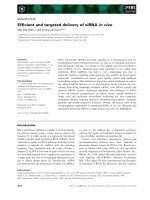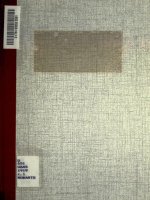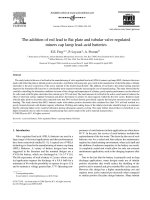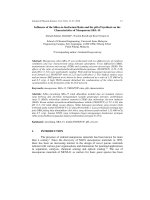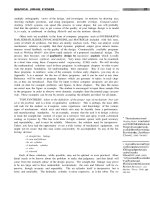Targeted delivery of doxorubicin conjugated to folic acid and vitamin e d a tocopheryl polyethylene glycol succinate (TPGS
Bạn đang xem bản rút gọn của tài liệu. Xem và tải ngay bản đầy đủ của tài liệu tại đây (2.91 MB, 155 trang )
TARGETED DELIVERY OF DOXORUBICIN CONJUGATED TO
FOLIC ACID AND VITAMIN E D-α-TOCOPHERYL
POLYETHYLENE GLYCOL SUCCINATE (TPGS)
ANBHARASI VANANGAMUDI
NATIONAL UNIVERSITY OF SINGAPORE
2009
TARGETED DELIVERY OF DOXORUBICIN CONJUGATED TO
FOLIC ACID AND VITAMIN E D-α-TOCOPHERYL
POLYETHYLENE GLYCOL SUCCINATE (TPGS)
ANBHARASI VANANGAMUDI
(B.TECH., ANNA UNIVERSITY, INDIA)
A THESIS SUBMITTED FOR THE DEGREE OF MASTER OF
ENGINEERING
DEPARTMENT OF CHEMICAL AND BIOMOLECULAR
ENGINEERING/NANOSCIENCE AND NANOTECHNOLOGY
INITIATIVE (NUSNNI)
NATIONAL UNIVERSITY OF SINGAPORE
2009
ACKNOWLEDGEMENTS
First and foremost of all, I would like to take this opportunity to express my deepest gratitude and
appreciation to my supervisor Associate Professor Feng Si-Shen, for his invaluable advice,
encouragement, guidance and unconditional support throughout my candidature of research.
I wish to express my sincere thanks to my co-supervisor Dr. Ho Ghim Wei, for her constant
support, care and understanding all time during my candidature.
I am grateful to my senior, Cao Na, for her extended help and advice and who has imparted her
knowledge and expertise in the experimental work through her sharing on research experience.
My warmest thanks to laboratory colleagues, Mr. Prashant Chandrasekharan, Mrs. Sun Bingfeng,
Mr. Pan Jie, Mr. Liu Yutao, Mrs. Sneha Kulkarni for their cooperation and kind support.
My special thanks to my friends Ms. Anitha Paneerselvan and Mr. Gan Chee Wee, from our
group for having enlightened my knowledge by thoughtful discussions and timely help.
I would also like to thank the lab officers, Mrs. Tan Mei Yee Dinah, Mr. Boey Kok Hong, Ms.
Chai Keng and the other lab officers from Chemical and Biomolecular Engineering and NUSNNI
department for their kind help in carrying out my experiments.
I am also thankful to Mr. Jeremy Loo Ee Yong, Mr. James Low Wai Mun, Mr. Shawn Tay Yi
Quan and other lab officers at the animal holding unit.
My heartfelt thanks to my family and friends, who have always been there for me through the
toughest of all times. This work is dedicated to my lovable parents.
My sincere thanks to the Nanoscience and Nanotechnology Initiative (NUSNNI) and Department
of Chemical and Biomolecular Engineering, National University of Singapore for their financial
support.
i
TABLE OF CONTENTS
ACKNOWLEDGEMENTS………………………………………………………………………...i
TABLE OF CONTENTS………………………………………………………………………….ii
SUMMARY………………………………………………………………………………………vii
NOMENCLATURE………………………………………………………………………………ix
LIST OF TABLES………………………………………………………………………………...xi
LIST OF FIGURES………………………………………………………………………………xii
LIST OF SCHEMES……………………………………………………………………………...xv
CHAPTER 1: INTRODUCTION………………………………………………………………….1
1.1 General Background…………………………………………………………………..1
1.2 Objectives of My Research…………………………………………………………..4
1.3 Thesis Organization…………………………………………………………………..5
CHAPTER 2: LITERATURE REVIEW…………………………………………………………..6
2.1 Cancer: A Deadly Disease…………………………………………………………….6
2.1.1 Overview of Cancer………………………………………………………...6
2.1.2 Cancer Prevalence, Causes and Risk Factors………………………………6
2.1.3 Cancer Treatment………………………………………………………….10
2.1.4 Cancer Chemotherapy and its Evolution………………………………….13
2.1.5 Barriers encountered in Cancer Chemotherapy…………………………...17
2.1.5.1 Solubility………………………………………………………..17
2.1.5.2 Macrophages Uptake…………………………………………...18
2.1.5.3 Multi Drug Resistance (MDR effect)…………………………..19
2.1.5.4 Stability and Absorption in Small Intestine…………………….21
2.1.6 Problems and Side Effects in Chemotherapy……………………………..22
2.1.7 Engineering Aspects of Cancer Chemotherapy…………………………...25
2.2 Polymers as Drug Carriers in Drug Delivery System………………………………..25
2.2.1 Synthetic Polymers………………………………………………………..26
ii
2.2.2 Natural Polymers………………………………………………………….28
2.2.3 Pseudosynthetic Polymers………………………………………………...29
2.3 Drug Targeting to Cancer Cells……………………………………………………...29
2.3.1 Active Targeting…………………………………………………………..30
2.3.1.1 Concept of “Magic Bullets”…………………………………….31
2.3.1.2 Folic Acid……………………………………………………....32
2.3.1.3 Monoclonal Antibody (Herceptin)………………………..........34
2.3.1.4 Polyunsaturated Fatty Acids……………………………………38
2.3.1.5 Hyaluronic Acid………………………………………………...40
2.3.1.6 Peptides…………………………………………………………41
2.3.2 Passive Targeting and EPR Effect………………………………………...42
2.4 Drug Delivery Strategies for Cancer Chemotherapy………………………………...44
2.4.1 Liposomes…………………………………………………………………44
2.4.2 Nanoparticles……………………………………………………………...45
2.4.3 Micelles……………………………………………………………………47
2.4.4 Microspheres………………………………………………………………49
2.4.5 Paste……………………………………………………………………….50
2.5 Prodrugs……………………………………………………………………………...50
2.5.1 Concept of Prodrugs………………………………………………………50
2.5.2 Why prodrugs? ……………………………………………………………51
2.5.3 Classification of Prodrugs…………………………………………………52
2.5.4 Polymer-Drug Conjugation………………………………………………..53
2.5.5 Ringsdorf model…………………………………………………………..55
2.5.6 Design of Polymeric Prodrugs…………………………………………….56
2.5.7 Critical Aspects of Polymer Conjugation…………………………………58
2.5.8 Characteristics of Prodrugs………………………………………………..60
2.5.9 Mechanism of Action……………………………………………………...60
2.5.10 Bioconversion of Prodrugs………………………………………………63
iii
2.6 Vitamin E TPGS, an amphiphilic polymer…………………………………………..65
2.6.1 Structure and Properties…………………………………………………...65
2.6.2 Absorption/Bioavailability Enhancer……………………………………..66
2.6.3 Solubilization of Poorly Water Soluble Compounds……………………...68
2.6.4 Controlled Delivery Applications…………………………………………68
2.6.5 Non-Oral Delivery Applications…………………………………………..69
2.6.5.1 Nasal/Pulmonary Delivery……………………………………...69
2.6.5.2 Ophthalmic Delivery…………………………………………...70
2.6.5.3 Parental Delivery……………………………………………….70
2.6.5.4 Dermal Delivery………………………………………………..70
2.6.6 Anti-cancer Activity………………………………………………………70
2.7 Doxorubicin, an anti-cancer drug……………………………………………………71
2.7.1 Structure and Properties…………………………………………………...71
2.7.2 Mechanism of Action……………………………………………………...72
2.7.3 Limitations and Side Effects………………………………………………73
2.7.4 Systems for Delivery of Doxorubicin……………………………………..74
2.8 Folic Acid…………………………………………………………………………….75
2.8.1 Structure and Properties of Folic Acid……………………………………75
2.8.2 Structure and Functions of Folate Receptors……………………………...76
2.8.3 Biological Mechanism…………………………………………………….77
2.8.4 Drug Delivery by Receptor Mediated Endocytosis……………………….78
2.8.5 Applications……………………………………………………………….79
CHAPTER 3: SYNTHESIS AND CHARACTERIZATION OF TPGS-DOX-FOL
CONJUGATE…………………………………………………………………………………….80
3.1 Introduction…………………………………………………………………………..80
3.2 Materials……………………………………………………………………………..80
3.3 Methods………………………………………………………………………………81
3.3.1 Synthesis of TPGS-DOX………………………………………………….81
iv
3.3.1.1 Succinoylation of TPGS………………………………………..81
3.3.1.2 TPGS-DOX Conjugation……………………………………….82
3.3.2 Synthesis of TPGS-DOX-FOL……………………………………………83
3.3.2.1 Folate-Hydrazide Synthesis…………………………………….83
3.3.2.2 TPGS-DOX-FOL Conjugation…………………………………84
3.3.3 Characterization of TPGS-DOX and TPGS-DOX-FOL Conjugates……..85
3.3.3.1 FT-IR…………………………………………………………...86
3.3.3.2 ¹H-NMR………………………………………………………...86
3.3.3.3 Drug Conjugation Efficiency…………………………………...86
3.4 Results and Discussion………………………………………………………………87
3.4.1 FT-IR Spectra……………………………………………………………..87
3.4.2 ¹H-NMR Spectra…………………………………………………………..88
3.4.3 Drug Loading Efficiency………………………………………………….89
3.4.4 Conclusions………………………………………………………………..90
CHAPTER 4: IN VITRO STUDIES ON DRUG RELEASE KINETICS, CELLULAR UPTAKE
AND CELL CYTOTOXICITY OF TPGS-DOX AND TPGS-DOX-FOL CONJUGATES…….91
4.1 Introduction…………………………………………………………………………..91
4.2 Materials and Methods……………………………………………………………….91
4.2.1 Materials…………………………………………………………………..91
4.2.2 In vitro Drug release………………………………………………………92
4.2.3 Cell Culture………………………………………………………………..92
4.2.4 In vitro Cellular Uptake…………………………………………………...93
4.2.5 Confocal Laser Scanning Microscopy (CLSM)…………………………..93
4.2.6 In vitro Cytotoxicity……………………………………………………….94
4.2.7 Statistics…………………………………………………………………...94
4.3 Results and Discussion………………………………………………………………94
4.3.1 In vitro Drug Release……………………………………………………...94
4.3.2 In vitro Cellular Uptake…………………………………………………...97
v
4.3.3 Confocal Laser Scanning Microscopy (CLSM)…………………………..99
4.3.4 In vitro Cytotoxicity……………………………………………………...101
4.4 Conclusions…………………………………………………………………………104
CHAPTER 5: IN VIVO STUDIES ON PHARMACOKINETICS AND BIODISTRIBUTION OF
THE TPGS-DOX-FOL CONJUGATE………………………………………………………….106
5.1 Introduction…………………………………………………………………………106
5.2 Materials and Methods……………………………………………………………...106
5.2.1 Animal Type……………………………………………………………..106
5.2.2 In vivo Pharmacokinetics………………………………………………...107
5.2.2.1 Drug Administration and Blood Collection……………….......107
5.2.2.2 Sample Analysis………………………………………………108
5.2.2.3 Pharmacokinetic Parameters…………………………………..108
5.2.3 In vivo Biodistribution…………………………………………………...109
5.2.3.1 Drug Administration and Tissue Collection…………………..109
5.2.3.2 Sample Analysis………………………………………………110
5.2.4 Statistics………………………………………………………………….110
5.3 Results and Discussion……………………………………………………………..110
5.3.1 In vivo Pharmacokinetics………………………………………………...110
5.3.2 In vivo Biodistribution…………………………………………………...113
5.4 Conclusions…………………………………………………………………………118
CHAPTER 6: CONLCUSIONS AND RECOMMENDATIONS………………………………119
6.1 Conclusions…………………………………………………………………………119
6.2 Recommendations…………………………………………………………………..121
REFERENCES………………………………………………………………………………….122
vi
SUMMARY
Targeted prodrug delivery is one of the promising drug delivery systems for cancer treatment.
Prodrug may improve the biological distribution and the half-life in the circulation as well as
reduce the systemic toxicity and the kidney excretion of the drug. Prodrug is an important
strategy to improve the solubility, permeability, stability and provide a means to circumvent the
multi-drug resistance (MDR). MDR is caused by the overexpression of MDR transport proteins
such as p-glycoproteins (p-gp) in the cell membrane, that efflux the drug by reducing the
intracellular drug levels for cancer chemotherapy. Tumors also acquire drug resistance through
induction of MDR transport proteins. At present, about 5-7% of the approved drugs worldwide
can be classified as prodrugs and approximately 15% of all new drugs approved within 2001 and
2002 were prodrugs. The conjugation of the drug with the polymer is a main strategy to form the
polymeric prodrug of the synergistic or additive effect, which occurs with enhanced and
simultaneous action of the drug and the polymer in destroying the cancer cells. The rationale for
polymer conjugation is to mainly prolong the half-life of therapeutically active agents by
increasing their hydrodynamic volume and hence decreasing their excretion rate. Polymeranticancer drug conjugate has been investigated and some prodrugs have been found successful.
Polymers such as N-(2-hydroxypropyl)methacrylamide (HPMA) copolymers, poly(ethylene
glycol) and poly(L-glutamic acid) (PGA) have been used often as the carriers for anticancer drugs
such as doxorubicin, paclitaxel, camphothecin and gemcitabine. Conjugation of TPGS should be
an ideal solution for the drugs that have problems in adsorption, distribution, metabolism and
excretion (ADME).
Doxorubicin (DOX) is an effective anticancer agent for cancer treatment, which is hampered by
its short plasma half life, low selectivity towards the tumor cells and serious side effects. This
vii
research developed a prodrug strategy to conjugate DOX to d-α-tocopheryl polyethylene glycol
succinate (TPGS) and folic acid (FOL) for targeted chemotherapy to enhance the therapeutic
effects and reduce the side effects of the drug. We synthesized 2 conjugates, TPGS-DOX and
TPGS-DOX-FOL to quantitatively evaluate the advantages of TPGS conjugation and FOL
conjugation through passive and active targeting effects. The successful conjugation was
confirmed by 1H NMR and FTIR. The DOX content in the conjugates was found to be 13wt% for
TPGS-DOX and 6 wt% for TPGS-DOX-FOL. The in vitro drug release from the conjugates were
found pH dependent, which is in favor of cancer treatment. The in vitro cellular uptake and
cytotoxicity were evaluated with MCF-7 breast cancer cells. It was found that the cellular uptake
of DOX increased 15.2% by TPGS conjugation and further 6.3% by FOL conjugation after 0.5
hour cell culture at 100 μM equivalent DOX concentration at 37°C, The mortality of the MCF-7
cells showed 23.2% increase by TPGS conjugation and further 31.0% increase by targeting effect
of FOL after 24 hour cell culture at 100 μM equivalent DOX concentration at 37°C. These
advantages were further confirmed by IC50 analysis. Cellular uptake of DOX, TPGS-DOX and
TPGS-DOX-FOL conjugates were also visualized by confocal laser scanning microscopy
(CLSM). The in vivo pharmacokinetics of the conjugates showed prolonged retention time of the
DOX in plasma, where they have almost same half-life. The biodistribution data showed that the
conjugates lowered the amount of drug accumulated in the heart, thereby reducing the
cardiotoxicity, which is said to be the main side effect of the DOX. Also, the gastrointestinal side
effect of the drug could be reduced by the TPGS-DOX-FOL conjugate, which has a 6.8- fold and
5.3- fold lesser amount of drug in stomach and intestine respectively.
The TPGS-DOX-FOL prodrug showed greater potential than the TPGS-DOX and DOX for it to
become a novel formulation for the delivery of doxorubicin. This can be applied to other drugs as
well.
viii
NOMENCLATURE
ACN
Acetonitrile
ADME
Adsorption, Distribution, Metabolism, Excretion
ATP
Adenosine Tri Phosphate
AUC
Area Under the Curve
BD
Biodistribution
CL
Clearance
CLSM
Confocal Laser Scanning Miroscopy
CMC
Critical Micelle Concentration
CyA
Cyclosporine A
DCC
N,Nʹ-dicyclohexylcarbodiimide
DCM
Dichloromethane
DMAP
Dimethylaminopyridine
DMEM
Dulbecco’s Modified Eagle Medium
DMSO
Dimethyl Sulfoxide
DOX
Doxorubicin
EPR
Enhanced Permeation and Retention
FBS
Fetal Bovine Serum
FT-IR
Fourier Transform Infrared Spectroscopy
FOL
Folic Acid
FR
Folate Receptor
GI
Gastrointestinal
GPI
Glycosyl phosphatidylinositol
HPLC
High Performance Liquid Chromatography
HPMA
N-(2-hydroxypropyl)-methacrylamide
ix
IC50
Drug concentration at which 50% cells die
MDR
Multi Drug Resistance
MRT
Mean Residence Time
MTD
Maximum Tolerated Dose
NHS
N-hydroxysuccinimide
NMR
Nuclear Magnetic Resonance
PBS
Phosphate Buffered Saline
PEG
Polyethylene glycol
PEI
Poly(ethyleneimine)
PGA
Poly(L-glutamic acid)
P-gp
P-glycoproteins
PHEG
Poly((N-hydroxyethyl)-L-glutamine)
PK
Pharmacokinetics
PLA
Poly(lactic acid)
PLGA
Copoly(lactic acid/glycolic acid)
PVA
Polyvinyl alcohol
PVP
Poly(vinylpyrrolidone)
RME
Receptor Mediated Endocytosis
SA
Succinic Anhydride
SMA
Poly(styrene-co-maleicacid/anhydride)
t1/2
Half-life period
TEA
Triethyl amine
THF
Tetrahydrofuran
TPGS
Vitamin E TPGS, d-α-tocopheryl polyethylene glycol 1000
succinate
x
LIST OF TABLES
Table 4-1 IC50 values (in equivalent µM DOX level) of MCF-7 cancer cells cultured with the
TPGS-DOX-FOL conjugate, TPGS-DOX conjugate and the pristine DOX in 24, 48 and 72
hrs………………………………………………………………………………………………103
Table 5-1 Pharmacokinetic parameters of the TPGS-DOX-FOL conjugate, TPGS-DOX conjugate
and the pristine DOX through i.v. injection at an equivalent dose of 5 mg/kg………………….113
Table 5-2 AUC values (μg.h/g) of biodistribution in various organs after i.v. injection of free
DOX or TPGS-DOX (T-D) or TPGS-DOX-FOL (T-D-F) conjugates to SD rats at 5 mg/kg
equivalent dose…………………………………………………………………………………..116
xi
LIST OF FIGURES
Fig 2-1 Timeline of events in the development of cancer chemotherapy………………………16
Fig 2-2 Macrophages uptake by phagocytosis……………………………………………………18
Fig 2-3 Human P-glycoprotein…………………………………………………………………...20
Fig 2-4 Mechanism of P-glycoproteins…………………………………………………………...21
Fig 2-5 Emergence of anticancer polymer therapeutics…………………………………………..26
Fig 2-6 List of ligand targeted nanoparticulate systems evaluated for in vitro and in vivo
therapeutics delivery……………………………………………………………………………...30
Fig 2-7 Dr. Paul Ehrlich…………………………………………………………………………..31
Fig 2-8 Cancer Therapy Progress since Ehrlich’s finding………………………………………..31
Fig 2-9 Folate mediated targeting………………………………………………………………...33
Fig 2-10 Antibody structure………………………………………………………………………34
Fig 2-11 Monoclonal antibodies for cancer………………………………………………………35
Fig 2-12 Monoclonal antibodies for various applications………………………………………..36
Fig 2-13 Herceptin action with breast cancer cells……………………………………………….37
Fig 2-14 Mechanism of action of Herceptin……………………………………………………38
Fig 2-15 PUFAs………………………………………………………………………………......39
Fig 2-16 Representation of EPR effect and active targeting for drug delivery to tumors………..43
xii
Fig 2-17 Liposome formation…………………………………………………………………….44
Fig 2-18 drug delivery by targeted nanoparticles………………………………………………...46
Fig 2-19 Structure of Micelle……………………………………………………………………..48
Fig 2-20 Microspheres……………………………………………………………………………50
Fig 2-21 An illustration of the Concept of Prodrug………………………………………………51
Fig 2-22 Polymer-drug conjugates………………………………………………………………..54
Fig 2-23 Ideal polymeric prodrug model………………………………………………………....56
Fig 2-24 Incorporation of spacers in prodrug conjugation……………………………………….57
Fig 2-25 Polymeric prodrug with targeting agent………………………………………………...58
Fig 2-26 Mechanism of action of polymer drug conjugate……………………………………….62
Fig 2-27 Selective release of active drugs in regions of low oxygen concentration in tumors…..64
Fig 2-28 Enzymes involved in biotransformation of prodrugs…………………………………...65
Fig 2-29 Doxorubicin intercalating DNA………………………………………………………...73
Fig 2-30 Receptor mediated endocytosis…………………………………………………………78
Fig 3-1 FT-IR Spectra of FOL, TPGS-DOX and TPGS-DOX-FOL……………………………..87
Fig 3-2 ¹H-NMR spectra of (a) TPGS-DOX with the insert for a higher magnification of the
region between 6 and 14 ppm, (b) FOL with the insert for a magnification of the region between 8
and 11 ppm and 3 and 4 ppm, (c) FOL-NH-NH2, (d) TPGS-DOX-FOL………………………...89
Fig 4-1 In vitro release of DOX from TPGS-DOX and TPGS-DOX-FOL conjugates incubated in
phosphate buffer at 37°C at 3 different pH (Mean±SD and n=3)………………………………...96
xiii
Fig 4-2 Cell uptake efficiency incubated with pristine DOX, TPGS-DOX or TPGS-DOX-FOL
conjugate for 0.5, 1, 4, 6 h respectively at an equivalent DOX concentration of 1µg/mL in MCF-7
breast cancer cells (Mean±SD and n=6)………………………………………………………….98
Fig 4-3 Confocal laser scanning microscopy (CLSM) of MCF-7 cells after 4 h incubation with (a)
TPGS-FITC, (b) pristine drug DOX, (c) FOL, (d) TPGS-DOX conjugate and (e) TPGS-DOXFOL conjugate at an equivalent DOX concentration of 1µg/mL……………………………….100
Fig 4-4 Cell viability of MCF-7 breast cancer cells after incubation with the TPGS-DOX
conjugate and TPGS-DOX-FOL conjugate in comparison with that of the pristine DOX after (a)
24, (b) 48, and (c) 72 h at various equivalent DOX concentrations (Mean+SD and n=6)……...101
Fig 5-1 Experimental SD rats, who had sacrificed their lives for the well being of human…….107
Fig 5-2 Pharmacokinetic profile of the pristine DOX, TPGS-DOX conjugate and TPGS-DOXFOL conjugate after intravenous injection in rats at an equivalent dose of 5 mg/kg (mean±SD and
n=4)……………………………………………………………………………………………...111
Fig 5-3 The amount of DOX (μg/g) in heart, lung, spleen, liver, stomach, intestine, kidney and
brain after i.v. administration at 5mg/kg equivalent dose of (a) the free DOX, (b) the TPGS-DOX
conjugate, (c) the TPGS-DOX-FOL conjugate (mean±SD and n=3)…………………………...114
xiv
LIST OF SCHEMES
Scheme 2-1 Chemical structure of SMA…………………………………………………………27
Scheme 2-2 Chemical structure of PEG………………………………………………………….28
Scheme 2-3 Hyaluronic Acid……………………………………………………………………..40
Scheme 2-4 Chemical structure of Vitamin E TPGS……………………………………………..65
Scheme 2-5 Structure of Doxorubicin……………………………………………………………71
Scheme 2-6 Structure of Folic Acid………………………………………………………………75
Scheme 3-1 Scheme of TPGS-DOX Conjugation………………………………………………..82
Scheme 3-2 Scheme of FOL-Hydrazide formation………………………………………………84
Scheme 3-3 Scheme of TPGS-DOX-FOL Conjugation………………………………………….85
xv
CHAPTER 1: INTRODUCTION
1.1 General Background
There has been intensive research on macromolecular ‘prodrugs’ in the field of drug delivery that
refers to modification of the drug’s molecular structure such that it makes an inactive form to be
administered and then to become active metabolite in the diseased cells. Prodrugs may improve
the biological distribution and the half-life in the circulation as well as reduce the systemic
toxicity and the kidney excretion of the drug (Cavallaro, Pitarresi et al. 2001; Zhang, Huey Lee et
al. 2007). Prodrug is an important strategy to improve the solubility, permeability, stability and
provide a means to circumvent the multidrug resistance (MDR). MDR is caused by the
overexpression of MDR transport proteins such as p-glycoproteins (p-gp) in the cell membrane,
that efflux the drug by reducing the intracellular drug levels for cancer chemotherapy (Schinkel
1997; Stella and Nti-Addae 2007). Tumors also acquire drug resistance through induction of
MDR transport proteins (Harris and Hochhauser 1992; Gottesman, Fojo et al. 2002). At present,
about 5-7% of the approved drugs worldwide can be classified as prodrugs and approximately
15% of all new drugs approved within 2001 and 2002 were prodrugs (Rautio, Kumpulainen et al.
2008). The conjugation of the drug with the polymer is a main strategy to form the polymeric
prodrug of the synergistic or additive effect, which occurs with enhanced and simultaneous action
of the drug and the polymer in destroying the cancer cells (Tarek. M. Fahmy 2005). The rationale
for polymer conjugation is to mainly prolong the half-life of therapeutically active agents by
increasing their hydrodynamic volume and hence decreasing their excretion rate. Polymeranticancer drug conjugate has been investigated and some prodrugs have been found successful
(Kopecek, Kopeckova et al. 2001; Jayant Khandare 2006; Pasut, Canal et al. 2008). Polymers
such as N-(2-hydroxypropyl)methacrylamide (HPMA) copolymers, poly(ethylene glycol) and
1
poly(L-glutamic acid) (PGA) have been used often as the carriers for anticancer drugs such as
doxorubicin, paclitaxel, camphothecin and gemcitabine (Greenwald, Choe et al. 2003; Chytil,
Etrych et al. 2006; Pasut, Canal et al. 2008). Several polymeric conjugates, for example, PEG
conjugation of paclitaxel, camptothecin, methotrexate, PLA-paclitaxel, PEG-Doxorubicin,
PLGA-paclitaxel have been developed earlier (Maeda, Seymour et al. 1992; Li, Yu et al. 1996;
Riebeseel, Biedermann et al. 2002; Veronese, Schiavon et al. 2005; Pasut 2007).
Most of the anticancer drugs do not differentiate between the cancerous cells and the healthy
cells, leading to their systemic toxicity and side effects by affecting the normal cells (BrannonPeppas and Blanchette 2004). The aim of targeted drug delivery is to decrease the non-specificity
to the healthy cells and increase the specificity to the cancer cells by attaching a targeting moiety
to the inactive prodrug such that the active drug may then be released in the cancer cells without
affecting the healthy cells (de Groot, Damen et al. 2001). The concept of targeting takes its effect
when Paul Ehrlich (1854-1915) first postulated the ‘magic bullet’. Targeted drug delivery system
has been considered as the promising way to increase the therapeutic effects of the antitumor
drugs by being specific to tumor cells and by having prolonged duration of drug action
(Sudimack and Lee 2000). This leads to reduction in the minimum effective dose of the drug.
Though the “passive targeting” is quite effective by the enhanced permeation and retention (EPR)
effect, “active targeting” by receptor mediated endocytosis (RME) is found to be more
advantageous for most of the anticancer drugs (Tarek. M. Fahmy 2005). Several drug conjugates
and drug encapsulated nanoparticles have been reported to actively target the cancer cells to
increase the anticancer effects of the drug (Li, Yu et al. 1996; Veronese, Schiavon et al. 2005).
Among the targeting moieties, vitamin folic acid (folate or FOL) has been widely employed as a
targeting moiety for various anticancer drugs. It is attracted for its high binding affinity, ease of
2
modification, small size, stability during storage, and low cost (Lee and Low 1995; Reddy and
Low 2000). The high-affinity folate receptor (FR), which is a cell surface-expressed molecule
containing folate binding proteins called GPI (glycosyl phosphatidyl inositol) (Lu and Low
2002), is overexpressed in almost all the carcinomas, but has a highly restricted distribution of
expression in normal cells. For this reason, folic acid has been covalently conjugated to
anticancer drugs for selective targeting against tumor, which can uptake the drug-FOL
conjugation by the receptor mediated endocytosis (RME) (Lee and Low 1995). It was reported
that folate-targeted liposomal doxorubicin in an MDR cell line can bypass the P-gp efflux effect
as compared to the free doxorubicin, showing the effective targeting delivery of doxorubicin by
folate (Goren, Horowitz et al. 2000).
A water-soluble derivative of natural vitamin E, D-α-tocopheryl polyethylene glycol 1000
succinate (TPGS) or vitamin E TPGS, which is an amphiphilic macromolecule comprising of
hydrophilic polar head and a lipophilic alkyl tail, has been used as an effective emulsifier as well
as a good solubilizer due to its bulky nature and larger surface area (Fisher 2002). Our group has
successfully applied TPGS to prepare nanoparticles of biodegradable copolymers such as PLATPGS and PLGA-TPGS for controlled and targeted delivery of paclitaxel, employed as a model
anticancer drug (Mu and Feng 2003; Zhang and Feng 2006; Lee, Zhang et al. 2007). TPGS can
enhance the solubility and bioavailability of poorly absorbed drugs by acting as a carrier in drug
delivery systems, thus providing an effective way to improve the therapeutic efficiency and
reduce the side effects of the anticancer drugs (Fisher 2002; Youk, Lee et al. 2005). It also
increases the drug permeability across the cell membranes and enhances the absorption of the
drug by inhibiting the P-glycoproteins, whereby acting as a vehicle for drug delivery system
(Dintaman and Silverman 1999; Mu and Feng 2003). The increased emulsification efficiency and
enhanced cellular uptake of nanoparticles by TPGS could result in increased cytotoxicity of the
3
drug to the cancer cells (Mu and Feng 2003). In recent studies, it is known that TPGS also
possesses potent antitumor activity and has effective apoptosis inducing properties (Dintaman and
Silverman 1999; Youk, Lee et al. 2005). TPGS should thus be an ideal candidate for polymeric
conjugation of the drugs that have problems in pharmacokinetics, i.e. in the process of adsorption,
distribution, metabolism and excretion (ADME).
Doxorubicin (DOX), an anthracyclinic drug is a DNA-interacting drug for various cancers
especially breast, ovarian, stomach, bladder, brain and lung cancers and is one of the most potent
anticancer agents after its discovery in 1969 (Blum and Carter 1974). However, application of
doxorubicin in clinical application has been limited because of its short half-life and its extremely
high toxicity to the normal cells, especially the heart and gastrointestinal cells, as well (Blum and
Carter 1974; Al-Shabanah, El-Kashef et al. 2000). It was indicated that when the cumulative dose
of doxorubicin reaches 550 mg/m², the risks of developing cardiac side effects would
dramatically increase (Petit 2004). Alternative formulations of doxorubicin have been developed
recently, which include folate targeted doxorubicin, DOX-GA3 prodrug, HPMA-doxorubicin
conjugate, doxorubicin-PEG-folate conjugate, DOX-PLGA-mPEG-folate micelles (Shiah,
Dvorak et al. 2001; Yoo and Park 2004; Yoo and Park 2004; Lee, Na et al. 2005; Veronese,
Schiavon et al. 2005).
1.2 Objectives of this Research
The objectives of this research is to develop a novel targeting polymeric prodrug, TPGS-DOXFOL, that is hoped to combine the advantages of TPGS and FOL applied individually in
formulation of prodrugs. The polymer-drug conjugation was confirmed by ¹H NMR and FT-IR.
The conjugation efficiency, stability and in vitro drug release from the conjugate were measured
and analyzed. The cellular uptake and in vitro cytotoxicity of the TPGS-DOXFOL and TPGS4
DOX conjugates were investigated by using MCF-7 breast cancer cells in close comparison with
the pristine drug. Also, the pharmacokinetics and biodistribution were investigated in SD rats for
pristine DOX, TPGS-DOX and TPGS-DOX-FOL conjugates.
1.3 Thesis Organization
The thesis includes six chapters. Chapter 1 gives a brief introduction to the research done. It
comprises of general background of the project and its objectives as well. Chapter 2 gives a
literature review, which was useful in developing novel ideas and concepts in this project and also
gives supporting evidences. Chapter 3 gives the materials required and procedures adopted for the
preparation of the conjugates. Chapter 4 explains the in vitro studies on drug release, cellular
uptake and cell viability of the conjugates and the DOX. Chapter 5 gives the in vivo
pharmacokinetics and biodistribution of the conjugates compared to the free DOX. Finally, the
conclusions of the project are drawn based on the results and the interpretations done, followed
by few recommendations for future work.
5
CHAPTER 2: LITERATURE REVIEW
2.1 Cancer: A Deadly Disease
2.1.1 Overview of Cancer
Cancer is a group of diseases characterized by uncontrolled growth and spread of abnormal cells
that might affect almost any tissue of the body. The spreading of the cancerous cells is called
‘metastasis’ ( It can result in death, if the spread is not
controlled. According to World Health Organization (WHO), cancer causes about 13 % of all the
deaths ( Cancer is also called malignancy. A cancerous
growth or tumor is referred to as a malignant growth or tumor. A non-malignant growth or tumor
is referred to as benign. Benign tumors are not cancerous. There are dozens of cancer types such
as prostate cancer, lung cancer, colorectal cancer, bladder cancer, cutaneous melanoma,
pancreatic cancer, leukemia, breast cancer, endometrial cancer, ovarian cancer, brain cancer, nonHodgkin lymphoma etc. General classification of cancer includes Carcinoma, Sarcoma,
Lymphoma, Leukemia, Germ cell tumor, Blastic tumor etc ( />
2.1.2 Cancer Prevalence, Causes and Risk Factors
Cancer is one of the leading causes of death with around 10 million people being diagnosed with
the disease each year. According to American Cancer Society, 7.6 million people died from
cancer all over the world during 2007 and about 1.4 million new cancer cases are expected to be
diagnosed in the year 2008 ( The 5-year relative survival
rate for all cancers diagnosed between 1996 and 2003 is 66 %, up from 50 % 1975 – 1977. The
6
National Institutes of Health estimate overall costs of cancer in 2007 at $219.2 billion:$89.0
billion for direct medical costs (total of all health expenditures); $18.2 billion for indirect
morbidity costs (cost of lost productivity due to illness); $112.0 billion for indirect mortality costs
(loss
of
productivity
due
to
premature
death)
( By the year 2050, the
global burden is expected to grow to 27 million new cancer cases and 17.5 million cancer deaths
simply
due
to
the
growth
and
ageing
of
the
population
( />Cancer may affect people at all ages but in most cases the number of cancer patient increases with
age. All cancers are almost caused by the abnormalities in the genetic material of the transformed
cells. These genetic abnormalities in cancer affect 2 types of genes namely Tumor suppressor
genes and Oncogenes. In cancer, the oncogenes are activated and the tumor suppressor genes are
inactivated. Here, the oncogenes are responsible for the hyperactive growth and division of the
cancer cells, to adjust in different environments and cause programmed cell death. Now the
Tumor suppressor genes are responsible for the loss in control over the cell cycle, adhesion with
other tissues and interaction with the immune cells. The 2 wide factors that cause the cancerous
cells are the external factors and the internal factors. The external factors include
Tobacco smoking
Chemicals
Radiation
Infections
Alcohol
Poor diet
Lack of physical activity or overweight
7
The internal factors include
Inherited mutations
Hormones
Growing older
Immune conditions.
These factors are said to be the most common risk factors for cancer. Many of these risk factors
can be avoided and several of these factors may act together to cause normal cells to become
cancerous. The chemicals that cause cancer are called carcinogens and those chemicals that cause
cancer through mutations in DNA are called mutagens. All mutagens are carcinogens, but all
carcinogens are not mutagens. They cause rapid rates of mitosis of the cells and thus inactivate
the enzyme that does the DNA repair. One of the most important carcinogens is tobacco.
Smoking and its related disease remains the world’s most preventable cause of death and so is the
cancer also. According to National Cancer Institute (NCI), each year, more than 180,000
Americans die from cancer that is related to tobacco use. Tobacco smoking accounts for at least
30 % of all cancer deaths and 87 % of lung cancer deaths. The risk of developing lung cancer is
about 23 times higher in male smokers and 13 times higher in female smokers compared to nonsmokers ( Also, quitting
smoking substantially decreases the risk of cancer. Prolonged exposure of radiation such as ultra
violet radiation from the sun, sun lamps and tanning booths causes early ageing of the skin and
skin damage that can lead to skin cancer. Ionizing radiation usually causes cell damage that leads
to cancer. This kind of radiation comes from the rays that enter the earth’s atmosphere from outer
space, radioactive fallout, radon gas, x-rays and other sources. The radioactive fallout can come
from accidents at nuclear power plants or from the production, testing or use of atomic weapons.
People exposed to fallout may have an increased risk of cancer, especially leukemia and cancer of
thyroid, breast, lung and stomach. Radon is a radioactive gas that we cannot see, smell or taste.
8

